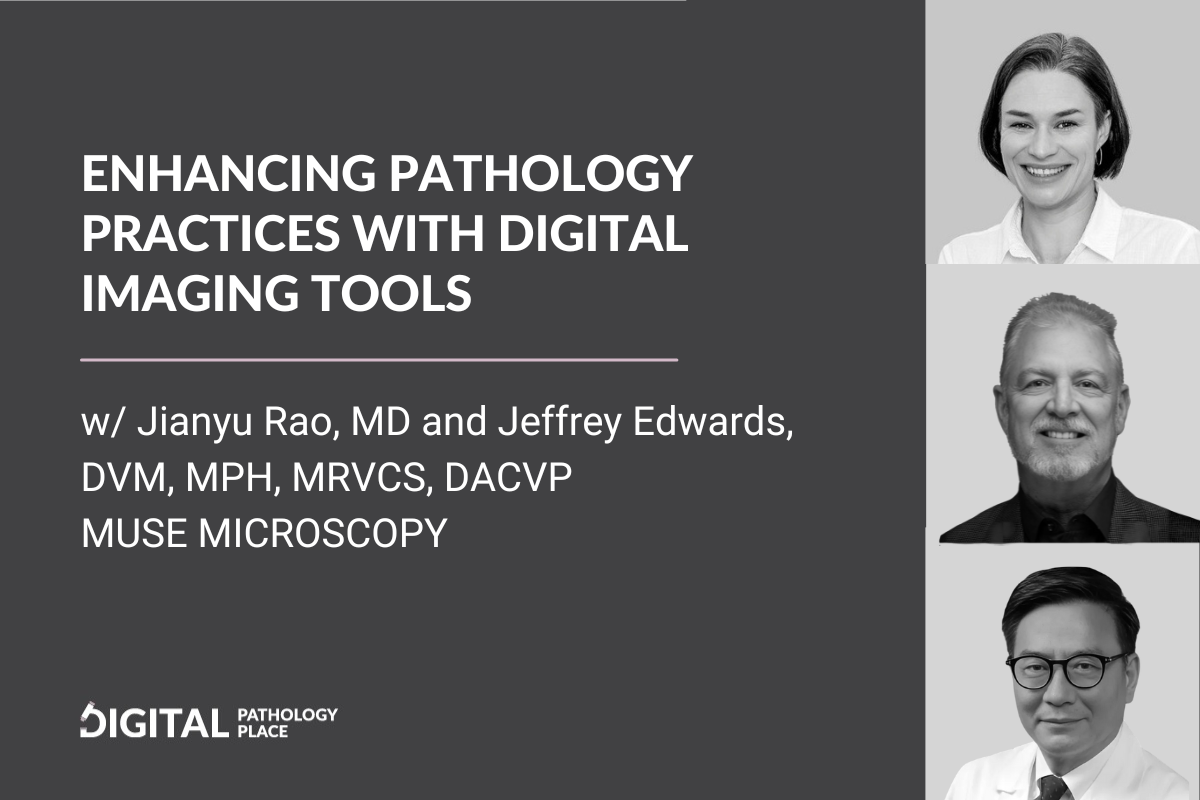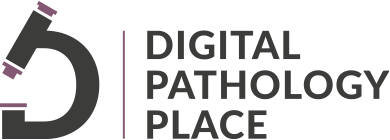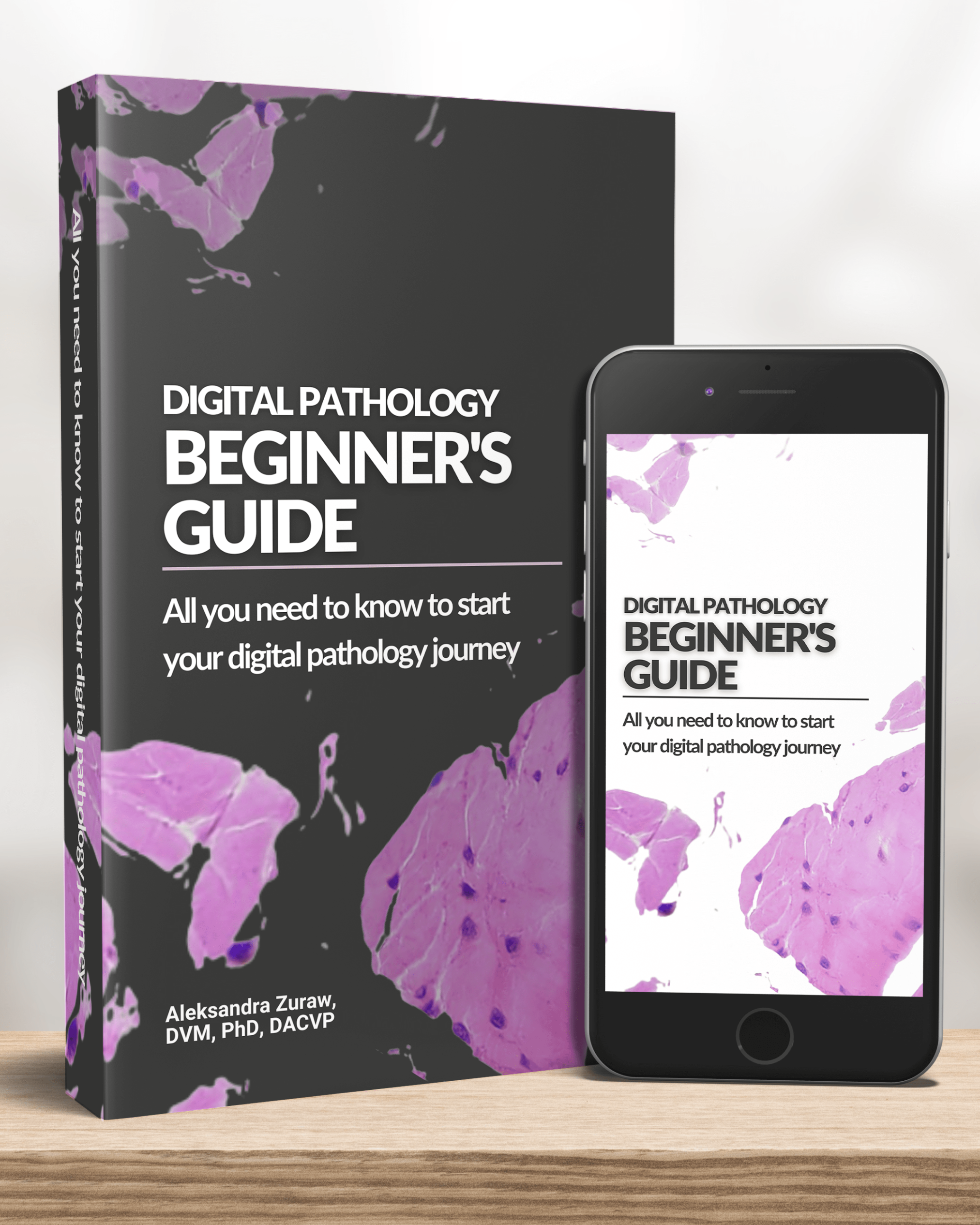In this episode of the Digital Pathology Podcast, I speak with Dr. Rao and Dr. Edwards about the practical impact of SmartPath, a direct-to-digital imaging system developed by MUSE Microscopy. Together, we explore how this device is transforming workflows across both veterinary and human pathology by eliminating the need for slide preparation, reducing diagnostic delays, and tackling technician shortages.
ENHANCING PATHOLOGY PRACTICES WITH DIGITAL IMAGING TOOLS WITH JIANYU RAO, MD AND JEFFREY EDWARDS, DVM, MPH, MRVCS, DACVP OF MUSE MICROSCOPY

ENHANCING PATHOLOGY PRACTICES WITH DIGITAL IMAGING TOOLS WITH JIANYU RAO, MD AND JEFFREY EDWARDS, DVM, MPH, MRVCS, DACVP OF MUSE MICROSCOPY
Discover how SmartPath is:
- Being implemented in real-time prostate and breast cancer diagnostics
-
Supporting point-of-care decisions in veterinary hospitals
-
Helping pathologists overcome image interpretation learning curves
-
Delivering faster turnaround, financial benefits, and greater diagnostic clarity
This episode is packed with personal stories, clinical examples, and financial insights—perfect for anyone considering a shift to glassless, AI-enabled pathology.
EPISODE RESOURCES
CONTENT EPISODES YOU WILL ENJOY
- This New Way to See Disease Will Transform Medicine. Direct to Digital Imaging in Pathology w/ Matthew Nuñez | CEO, MUSE Microscopy, Inc.
- The New Era of Pathology: Introduction to Digital Pathology Workflow with Slide-free Technology
- Pathology Meets AI: Combining Veterinary and Medical Pathology for Digital Advancements w/ Richard Doughty, DVM, MD, MSc AIFORIA
- Virtual H&E. How Instapath uses optical sectioning microscopy to accelerate pathology diagnosis w/ David Tulman, Instapath
- How AI is Transforming Veterinary Diagnostics w/ Richard Fox, DVM, Dipl ECVP | Aiforia
TRANSCRIPT
Introduction to SmartPath Technology
Aleks: What if you could skip glass slides altogether and go straight from fresh tissue directly to digital image? That’s exactly the future. MUSE microscopy is building with the device called Smart Path, a tissue imaging device that captures diagnostic quality images directly from fresh tissue. Join me as I ask them about their firsthand insights on what’s easy.
What’s challenging and what went wrong as they bring this technology to life? Let’s dive into it.
Intro: Learn about the newest digital pathology trends in science and industry. Meet the most interesting people in the niche and gain insights relevant to your own projects. Here is where pathology meets computer science.
You are listening to the Digital Pathology Podcast with your host, Dr. Alekzandra Zuraw.
Meet the Experts: Dr. Rao and Dr. Edwards
Aleks: I have Dr. Rao and Dr. Edwards here, an MD pathologist and a veterinary [00:01:00] pathologist, and we just came out of a panel about MUSE microscopy. MUSE is the technology that lets you image tissue direct to digital. And I have a couple of questions because the plan is.
FDA Approval and Implementation Plans
Aleks: To have this device approved by the FDA in Q1 next year, 2025, and I wanted to ask you when it’s gonna be implemented. There, there are, commercial plans and everything, but when it comes to change management. For the decision makers in the veterinary pathology space and MD pathology space and the users, so we have decision makers and users change management.
How is it gonna differ? What is, what are these issues in change management gonna be in veterinary pathology and in MD pathology?
Dr. Edwards: You mentioned FDA approval. That’s not something we need to worry about. In veterinary medicine, the deployment of veterinary medicine will be point of care at hospitals.
Dr. Edwards: The first group that will have to be [00:02:00] trained and see this in a different way, are gonna be the end use of the pathologist not used to seeing these native images and the virtual H&E images look somewhat different than what they’ve used to on a two dimensional glass slide or whole slide image.
So it’s gonna require training to learn how to interpret some of these images and to get comfortable with diagnosing them. And that will be very similar to, we have a great historical case to, to ease that transition. And that was the transition we did from glass slide to whole slide images.
And when we did that some years ago at anti-tech diagnostics and we went all in full blast, 40x, all slides were image, but we gave the pathologist two modalities. To look at, obviously, and that was the whole side image as well as the glass slide. And gave them some months to be able to make that transition to prove to them that they, that what they saw as a whole side image was [00:03:00] in fact, compatible similar to the glass slides.
So it’s gonna require this same sort of thing with MUSE. With the MUSE images, the SmartPath images, they’re gonna need to look at the SmartPath images, and the whole side images that are sent to the reference labs from the hospitals where the SmartPath image was done to be able to see those side by side and so that they get the confidence and build on that confidence that, yes, my diagnosis I’ve made here is in fact the same as what I’m used to looking at whole side image or not, right?
And then decide what over time. Learning from that experience and what they feel comfortable doing.
Aleks: Is it similar or different than veterinary? In human pathology?
Immediate Applications in Human Pathology
Dr. Rao: In human pathology, there’s one area that actually is the same. No, FDA needed, which is translational tissue banking.
Aleks: Okay.
Dr. Rao: Okay. Yeah. So that’s something that we can immediately do. Like in my institutions we have several big program [00:04:00] project for cancer, one of which is prostate. And typically, for banking of the tissue of the prostate, we have to do a lot of, processing, frozen section and analysis to find a tumor area, right?
So this can help us on that launch so I can immediately implement that even without have to wait on on the FDA study. Now that’s nonclinical translational. Now in the clinical setting, I think the area that we can do immediate helping us would be like, for example, breast pathology.
When we receive a lumpectomy mastectomy, when we do the glossing, we maybe see different nodules and the patient may have already have chemo, right? So the nodule may not be in a tumor anymore, right? Or they’re maybe necrotic. In order to really be more efficient in processing tissues [00:05:00] for most molecular immuno studies that important for patient care, for the management, this can help us to finding that area of tumor and then say, oh, this is it. So let’s take tissue here to directly to the molecular study or immuno study. And that will be, affecting. The whole management scheme, because the oncologist can get the results much faster and probably even more precise because we have shown that the tissues processed, the bad news gave a better i a quality compared to tissue that fixed, informative.
And that’s why important for the patient care,
Addressing Pathologist Concerns
Aleks: Do you think, how do you think pathologists are gonna feel about it in terms of change management? Or are they gonna embrace it immediately? Or is there gonna be a transition period? What’s gonna [00:06:00] be the thing that will need to happen to convince them that this is.
Than you think that they wanna use.
Dr. Rao: Very important question. And just to use the breast as example, okay here, but there are many other settings that we, pathology need help. We see immediate, this can help us. But let’s start with the breast because again, I think one thing that this can help us is to be able to know where the tumor is while you using a grow even very experienced pathologist, if it’s just by naked eye, you won’t be able to tell, so this can give me immediately say, this is the tumor and I have to, think about, using that area of tissue to do this study.
That’s something can be immediately helpful. And that’s the key. Yeah. If you have a technology, try to take away my job. That is different story. Okay. But this is not, this is [00:07:00] actually help us. The other setting that really can be helpful is like when you do the intervention, radiology biopsy, co biopsy, we have to send our cytotechs.
We have to send our, if sometimes pathologist to go to do the adequacy or to do like rapid assessment, something we call ROSE. And sometimes preliminary diagnosis too based on that. But anyway, if I have this tool that I can immediately utilize it to do this job for me so that I can do, put my time on other important things.
So that’s the reason that I think this can be helping us in the practice, not just in, see this as a way to replace pathologist, responsibility. It’s totally different. It’s the addition. It is something that can help the patient care down the line, but. Help everybody.
So…
Aleks: I think you, you touched on a key point. This is not something that is in, that is gonna take away anybody’s job. [00:08:00] It’s making pathologists be able to help the patients faster. And I think this regardless, there’s gonna be a learning curve. There’s gonna be time for pathologists to get used to.
And Jeffrey mentioned. That there needs to be incorporated transition period for people to feel comfortable and that’s regardless whether it’s veterinary pathology or human pathology, basically the pathologist can help the patient faster. And so I think that’s something that people are gonna be super excited and that’s gonna help.
Adopted technology. Anything veterinary pathology or MD pathology specific that people are gonna be excited about other than that, that they can be faster and help patient faster?
Dr. Edwards: I think that, for instance, once additional studies are done, we’ve finished one study showing pathologists that with a hundred a thousand reads compared to reference, there was a 90% accordance plus minor discordances agreement.
When they see those kind of studies and we have a library of what these tissues look [00:09:00] like that they can see for themselves, they’ll gain more confidence. I firmly believe that the pathologists working for companies that have this technology, and I know this from when we did the digital pathology conversion, the first veterinary laboratory to do that well in advance with that laboratories, there was this, an amazing, one of my favorite words, esprit de corps in my pathology group.
This wonderful feeling of we did this together and we did something, a tremendous accomplishment that has greatly helped veterinary medicine. The same thing is gonna happen with this. Whatever company gets this and those pathologists that use it and they see how quickly they can make diagnosis that’s gonna improve patient care, decision making and patient care, they’re gonna realize we’re ahead of the pack.
We, we revolutionized a hundred years of the same old stuff. We did something different, a massive [00:10:00] breakthrough. That in itself is gonna be a wonderful feeling for the group that did that. And as far as replacing jobs, I agree there’s not gonna be any of that. Last slides whole slide images are gonna be the gold standard for years to, will be a time where reference laboratories start seeing.
Some of the biopsy is being replaced by this sort of technology. There may be some pushback in time. It reminds me of when medical transcription slowly got pushed out for voice activation like dragon. It reminds me of that’s what’s gonna eventually happen slowly over time in the future, but that’s years to come.
Aleks: So this feeling of accomplishment that you’re mentioning, we did at Charles River Laboratories where I work we did go digital the first time for primary reads in 2022 or 2021. I don’t remember. I was on the validation team and I totally underestimated the [00:11:00] joy when you actually accomplish it. Yeah. I thought, okay, it’s your job.
You work for a corporation, it’s like part of your job description and you just do it. But now when I think about it and I think yes, we are ahead of the pack and I did it together with my colleagues, we did it and we’re using it and it does gives me this sense of pride that I think you don’t really get from, you do, but.
In this context of that you get it more when it’s a startup environment. It doesn’t really matter what kind of environment it is. It matters that a group of people together achieve that and are leading. And its is a joyful feeling.
Dr. Edwards: It’s a pure morale boost. And yeah, again, the pride of collective joy and Free de Corp. There, there is no substitute. For management for that magic. When that happens, it sure makes management a lot easier. Yeah…
Aleks: I know.
Dr. Rao: I can see that. Just come back to the job of [00:12:00] loss of job issue. It’s actually not, obviously, we still, pathology has to read the image, but the problem with we, we are facing today in our pathology practice. It’s the shortage of the technologist. So we used to have a lot of people interested in CYTOTECHNOLOGY training, Cytotech school, and now we are facing problem. I’m the head of the medical director for Cyto Technologies, where UCLA.
I’m looking to close that. And there’s only one school left in California, so no more Cytotechs in the future. That’s dangerous. And then histotech, shortage. So what. Things can do to help with that problem technology. So I think this can help us, to really alleviate some of the problems that we are seeing in the technology training because it’s not a, because it’s something driving [00:13:00] not, there’s so many factors driving those changes.
Why do we don’t have cyto technology anymore? The cytotech was developed because of the pap smear. The Papsmear people try to push it away because of the HPV, testing and vaccine and all that out of the whole country. Everybody’s struggling with, how to deal with that because this typically cytotech training is very rigorous and, so again, I think this is, to my mind, this is technology that help to fill the gap to alleviate the problems that we’ve seen in that front.
Dr. Edwards: Alex, in the seminar we just gave. Did it surprise you and or make you feel good? When one of the MD pathologists said, how many times did we have to hear that our technicians were short technicians and the slides are delayed?
Aleks: Yes. And that’s a cross…
Dr. Edwards: That made me feel great. I’m sorry for you guys, but that we do deal that all the time.
So it seems to be a universal [00:14:00] issue. Yeah. I always thought we would lose our technicians. To, to the MD pathologist. But I guess the problem is the same with you.
Aleks: Yeah, and it’s the same in Tox safety basically. And the point to emphasize here is it’s not that it’s gonna be taking away some jobs.
There are no people to do those jobs. Exactly. But the job still needs to be done. How are we going to do it? And this is where, any technology comes in. So I’m excited about this one.
Financial Viability and ROI
Aleks: One more, one more question about the finances. Obviously, veterinary pathology, veterinary medicine and the human pathology, human medicine are financed differently.
How is the implementation gonna be solved from the financial perspective? Jeff, you mentioned it’s gonna be point of care, so it’s gonna be the investment of those managing the clinics. How do you see it being financially viable? [00:15:00] And like in general, what do you think about that?
Dr. Edwards: How do I see it being financially viable at the hospitals?
Aleks: Yeah. And basically who’s gonna be paying for this technology? Okay. How is it gonna, how will they, how fast and how will they get the return on investment?
Dr. Edwards: Sure. That’s critical. Return on investment. There’s no third party pays in medicine, like in, in in Ralph’s profession.
But I think this has been worked out pretty well. We looked at MUSE with Antec some years ago. And subsequent to that the diagnosis it’s made from a SmartPath image at a hospital, we charged a stat fee. Okay. So that’s gravy on top of the regular biopsy fee. And many owners are being willing.
I would, will, I would pay that in a moment. If I’m gonna get my dogs, my beloved dog has his diagnosis.
Aleks: Immediately
Dr. Edwards: On skin mass he has right now. If I can get it today, if I know, and if it’s malignant, [00:16:00] did they get the margins? Every margin is checked. That’s another stat fee, right? That’s another tissue put into the SmartPath unit.
So that is how that’s going to pay for itself. And also the… The more samples that are run well, the cost-effectiveness becomes even better. Yeah, I would say that’s the way it’s gonna work.
Aleks: I like that, I like that you say it’s gonna pay for itself because through the benefit for the owners and for the patients the added value justifies the investment from all the parties, from the party who has to purchase the unit and actually invest ahead of getting revenue from that.
And it totally justifies this for the patient for the pet owner.
Dr. Edwards: You’ve seen the video that we did and let you do where a veterinary surgeon in surgery with a large breed dog takes a piece of an organ. Let’s say it’s a spleen, if the surgeon [00:17:00] knows right away within a few minutes, if it’s a malignancy.
They then have the abi… instead of sewing this dog back up and waiting 4, 5, 6 days for a spleen, it could be a week to get a diagnosis. In the meantime, if it is malignant, it’s poor patients suffering. And then the decision has to be made, whether it’s chemotherapy or whatever’s gonna be done or not.
But if they knew right, then the surgeon knew right then if it’s a malignancy. They can then call the owner right then and say, here’s the situation. Here’s how bad this malignancy is. Here’s a life expectancy. We can make a decision right now. So the owner is then empowered to make a decision not to move forward or to do so, understanding the prognosis and what costs will be for treatment.
That is an extremely important thing for owners and they’re gonna be willing to pay for that knowledge.
Dr. Rao: I think on the human side it’s probably more complicated.
Aleks: Yes, yes.
Dr. Edwards: Always.
Dr. Rao: I think this is tremendous. This is music to the, [00:18:00] for the administrator hospital because think about it, if you have to set up a histology lab and how much you have to invest for that.
And so this, is the place. You don’t have to worry about embedding machine cutting, machine staning station and all that, and the human cost. So of course everything’s driving by CPT coding, right? Yes. So…
Aleks: magic
Dr. Edwards: C and the cd.
Dr. Rao: But so I think for this to be viable, obviously, I don’t know, this has to be a new, probably have to get a new CT just like digital or any other means.
So we typically have like technical component and professional component, right? I mean obviously this is not gonna change any professional component. Yeah, stay the same. The technical component may be something that needs to be added now that can be also replacing some of these things. So in the end, obviously it’s tremendously financially saving. [00:19:00]
Project. So I think that’s the way that I see it, at least on the human side,
Aleks: which is in contrast with the classical way we’re doing digital pathology, where, there, there have been return on investment calculators developed and but it’s always very long-term term and you are not cutting out anything from your current workflow.
So there is no direct savings. As much as I love digital pathology in any shape or form, and this shape and form seems to be easier to digest for the decision makers because it provides direct financial incentives to implement.
Conclusion and Future Prospects
Aleks: Thank you so much for joining.
Dr. Edwards: Thank you very much.
Aleks: It was a pleasure and I hope we meet again.
Dr. Edwards: Absolutely.
Dr. Rao: Good conversation. Thank you.
Aleks: Thank you so much for staying till the end. It means you are a real digital pathology trailblazer. And if you’re interested [00:20:00] to learn more about this technology, I’m gonna link in the cards and in the show notes, the podcast with Matthew Nunez, the CEO of MUSE microscopy, and if you happen to meet them at any pathology conference.
Be sure to check out the booth and check the device yourself because you can get a real life demo and have a look at the images created with the SmartPath device Yourself and I talk to you in the next episode.













